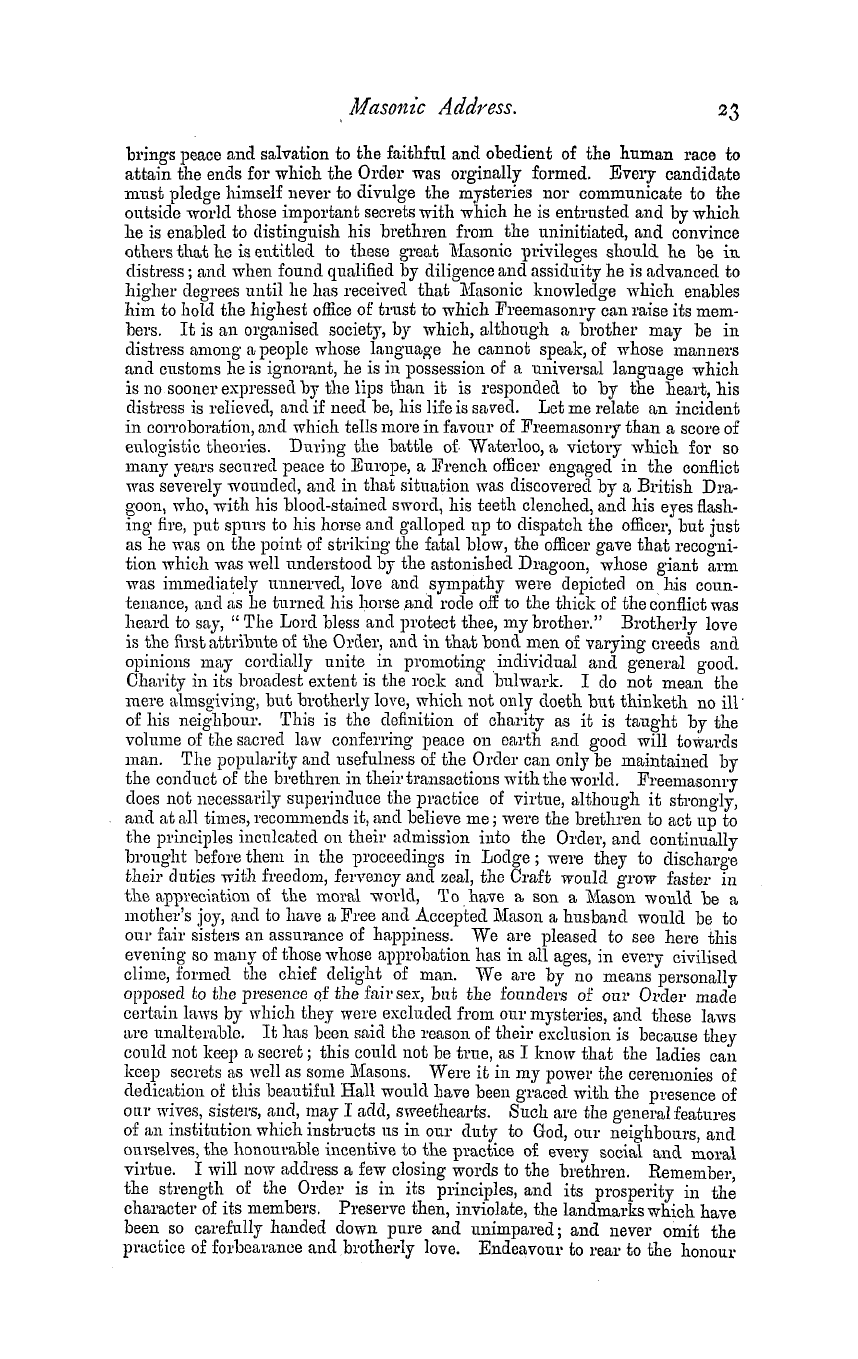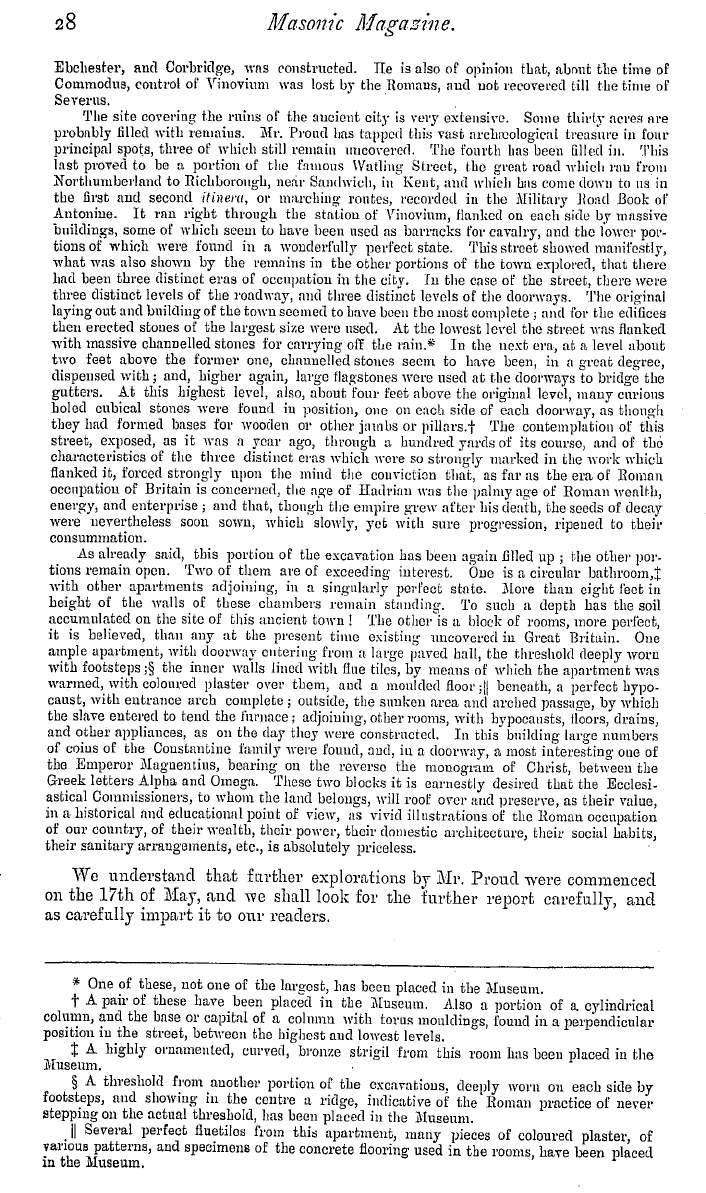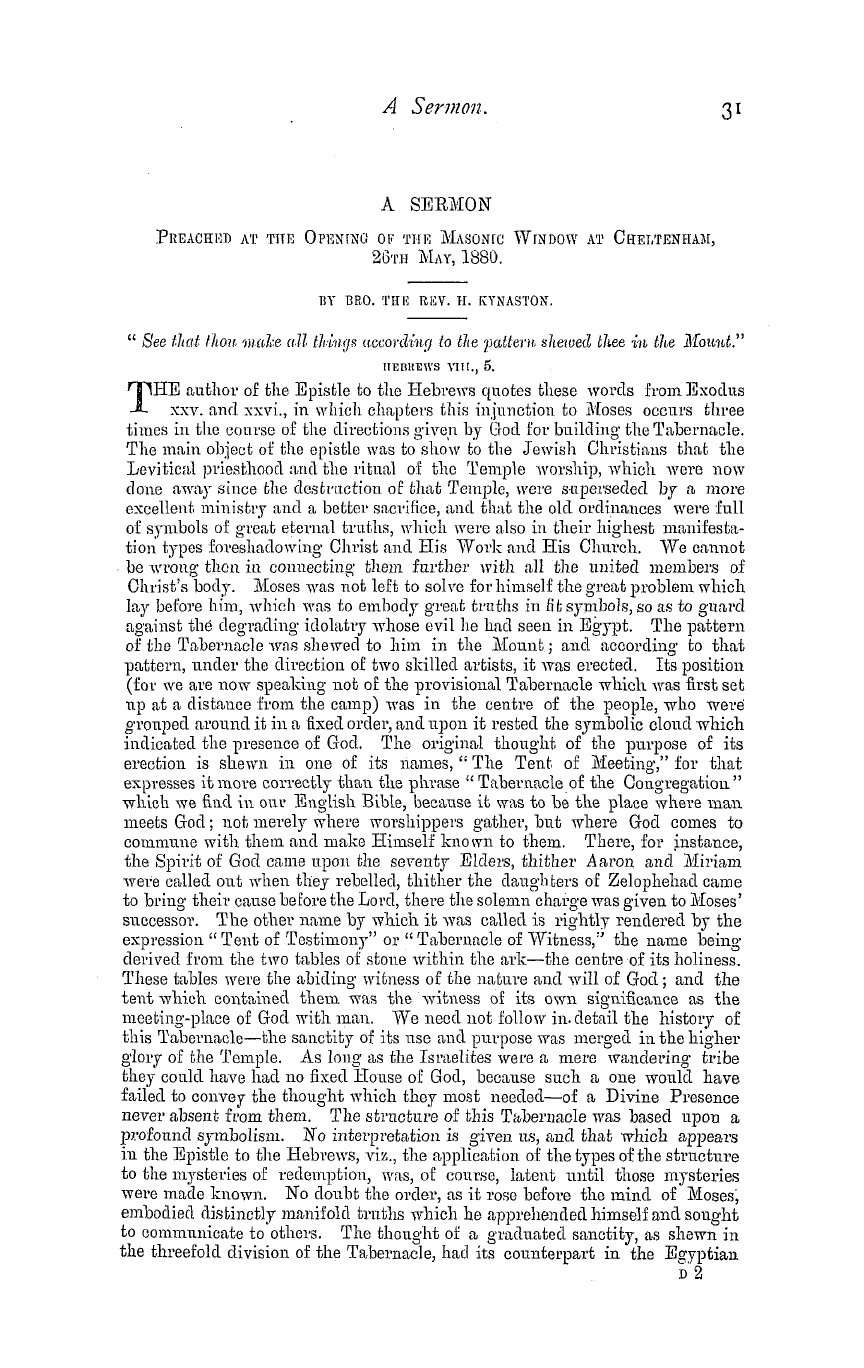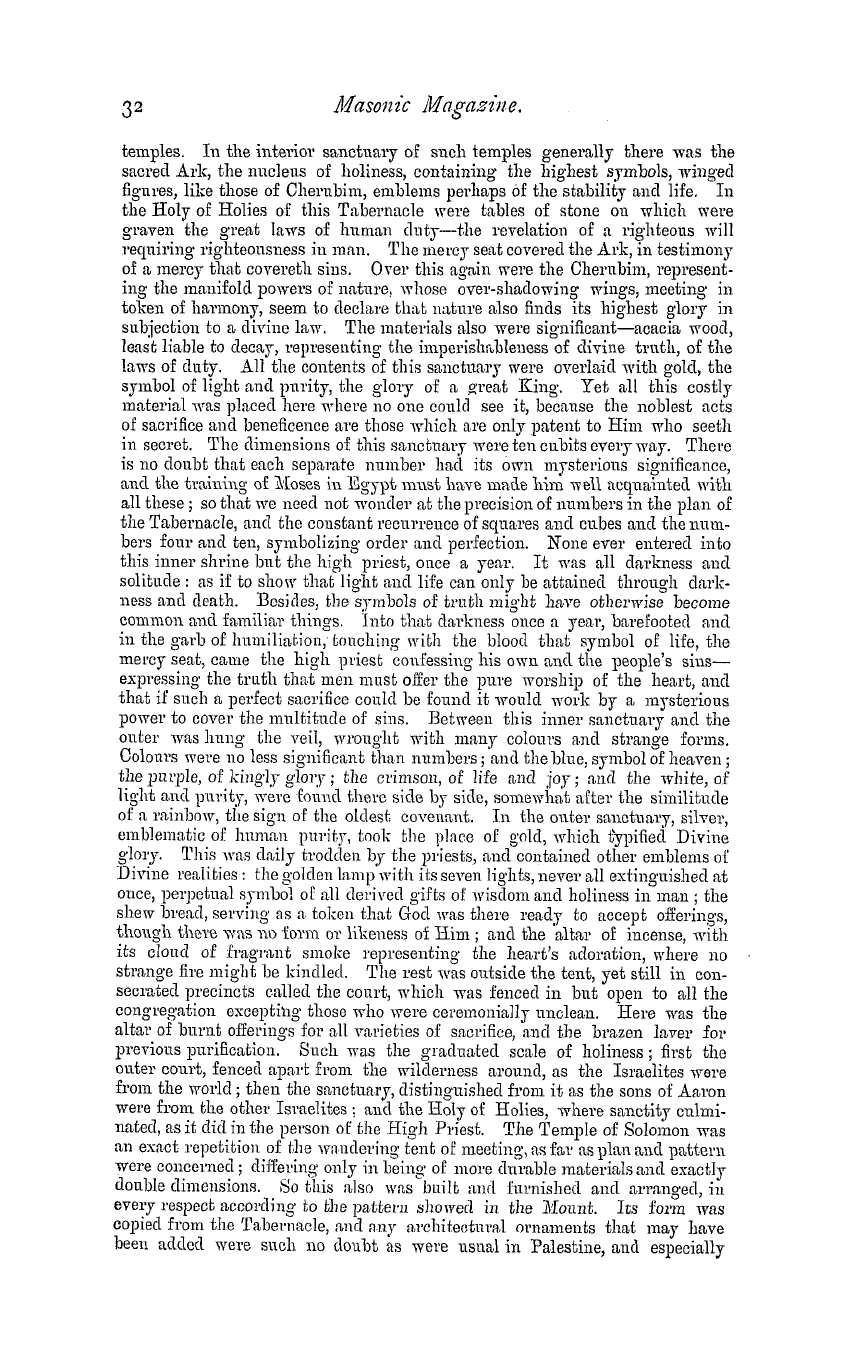-
Articles/Ads
Article MASONIC AND GENERAL ARCHAEOLOGIA. ← Page 4 of 4
Note: This text has been automatically extracted via Optical Character Recognition (OCR) software.
Masonic And General Archaeologia.
ancl inspire into us wisdom 'to contrive to Thy g lory ancl our own benefit , to guide ns in all our actions , give us strength to support ns under all difficulties , and bestow on ns all those beautiful virtues which are the peculiar ornaments of the members of those Thy heavenly mansions , where Thine honour dwells . Grant , 0 Thou that art the solo cause ancl spring of harmony , peace , and order , that we may be cemented together as brethrenand exercise a mutual charity
, and benevolence towards each other ; in all our dealing to do justice to all ; to love mercy , and thus walk humbly with Thee our God , the original of all things , that at last we may become members of that heavenly Jerusalem , which is Thy work alone , built without hands . Now to the Almighty , Eternal , Immortal , ancl Invisible Architect , the only w ise Gocl , be ascribed all honour , glory , might , majesty , and dominion from this time forth for evermore . Amen .
AN ARCHJEOLOGICAL DISCOVERY . —A curious discovery of an ancient refuse p it has recently been made at Corton , near Calne , in Wiltshire , by workmen who were employed in making a deep drain . At some four feet below the surface the men came upon four or five " sarsen" stones , the three largest measuring , roughly , 3 ft . hy 2 ft . Below was a great quantity of " rag " stones , much decayed , and partially turned into lime , as if b y the action of fire . Theseapparentlyhad formed the sides of a vaultof which the
, , , " sarsens " were the cover ; but the whole had fallen in , Among these stones ¦ were many bones of the horse ancl ox , ancl a few fragments of pottery . At the depth of 8 ft . there was a layer of chalk , and below that again were several feet of rich , black , strong-smelling mould , mingled with vegetable ashes , in wdvioh . were found several blade-bones ancl two skulls of the ox , and-also bones of red deer , horses , etc . There were also portions of three or four jars of fine
red ware , with round mouths and one handle ; these have been recognised as Romano-British . A good " thumb-flint , " for striking sparks , was also discovered among the earth thrown out of the drain . The original pit appeared to have been about 5 ft . in diameter , ancl sunk to a depth of 12 ft . in the greensand iron-mould . The chalk would come from the downs close at hand ; but it is stated that the coral rag stones are not found within a mile of the spot . The objects discovered are in the possession of the Vicar of Hilmarfcm .
AN AUGUSTAN EPIGRAM . —The Geneva correspondent of a contemporary writes as follows : — " According to the Bund , Professor Dr . Hagen , of Berne , has discovered in a Bernese manuscript of the 10 th century a hitherto unknown epigram of the Emperor Augustus . The greater part of the epigram is written iu Tironian notes ( ancient stenographic characters ) , and , according to the Professor ' s rendering , runs as follows : —•
OCTAVIAXI AUGUSTI . Convivre ! Tetricas hodie secludite Curas ! Ne maculent niveum nnbila corda diem ! Omnia sollicitaj pellantur murmura mentis , Ut vacet indomitum pectus amicitiaj . Non semper gaudere licet : fugit hora ! Jocemur ! Difficile est Fatis subripuisse diem . A collection of epigrams by Augustus is mentioned in his biography by Suetonius , cap . 85 , and by Martial , Epigr . XL , n . 21 , of which it is supposed the one in question may have formed a part . "
Note: This text has been automatically extracted via Optical Character Recognition (OCR) software.
Masonic And General Archaeologia.
ancl inspire into us wisdom 'to contrive to Thy g lory ancl our own benefit , to guide ns in all our actions , give us strength to support ns under all difficulties , and bestow on ns all those beautiful virtues which are the peculiar ornaments of the members of those Thy heavenly mansions , where Thine honour dwells . Grant , 0 Thou that art the solo cause ancl spring of harmony , peace , and order , that we may be cemented together as brethrenand exercise a mutual charity
, and benevolence towards each other ; in all our dealing to do justice to all ; to love mercy , and thus walk humbly with Thee our God , the original of all things , that at last we may become members of that heavenly Jerusalem , which is Thy work alone , built without hands . Now to the Almighty , Eternal , Immortal , ancl Invisible Architect , the only w ise Gocl , be ascribed all honour , glory , might , majesty , and dominion from this time forth for evermore . Amen .
AN ARCHJEOLOGICAL DISCOVERY . —A curious discovery of an ancient refuse p it has recently been made at Corton , near Calne , in Wiltshire , by workmen who were employed in making a deep drain . At some four feet below the surface the men came upon four or five " sarsen" stones , the three largest measuring , roughly , 3 ft . hy 2 ft . Below was a great quantity of " rag " stones , much decayed , and partially turned into lime , as if b y the action of fire . Theseapparentlyhad formed the sides of a vaultof which the
, , , " sarsens " were the cover ; but the whole had fallen in , Among these stones ¦ were many bones of the horse ancl ox , ancl a few fragments of pottery . At the depth of 8 ft . there was a layer of chalk , and below that again were several feet of rich , black , strong-smelling mould , mingled with vegetable ashes , in wdvioh . were found several blade-bones ancl two skulls of the ox , and-also bones of red deer , horses , etc . There were also portions of three or four jars of fine
red ware , with round mouths and one handle ; these have been recognised as Romano-British . A good " thumb-flint , " for striking sparks , was also discovered among the earth thrown out of the drain . The original pit appeared to have been about 5 ft . in diameter , ancl sunk to a depth of 12 ft . in the greensand iron-mould . The chalk would come from the downs close at hand ; but it is stated that the coral rag stones are not found within a mile of the spot . The objects discovered are in the possession of the Vicar of Hilmarfcm .
AN AUGUSTAN EPIGRAM . —The Geneva correspondent of a contemporary writes as follows : — " According to the Bund , Professor Dr . Hagen , of Berne , has discovered in a Bernese manuscript of the 10 th century a hitherto unknown epigram of the Emperor Augustus . The greater part of the epigram is written iu Tironian notes ( ancient stenographic characters ) , and , according to the Professor ' s rendering , runs as follows : —•
OCTAVIAXI AUGUSTI . Convivre ! Tetricas hodie secludite Curas ! Ne maculent niveum nnbila corda diem ! Omnia sollicitaj pellantur murmura mentis , Ut vacet indomitum pectus amicitiaj . Non semper gaudere licet : fugit hora ! Jocemur ! Difficile est Fatis subripuisse diem . A collection of epigrams by Augustus is mentioned in his biography by Suetonius , cap . 85 , and by Martial , Epigr . XL , n . 21 , of which it is supposed the one in question may have formed a part . "
















































